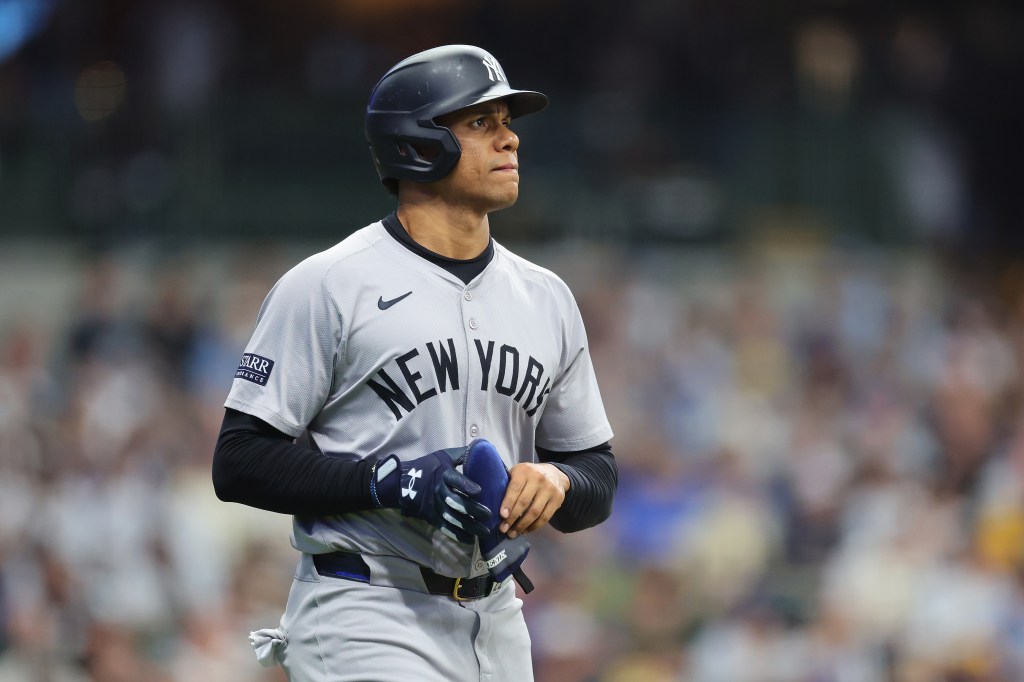Growing up in the Dominican Republic, Juan Soto swung at everything.
He didn’t have the patience to work a count as a child. Nor did he know how to get the most out of the sharp eyes he was born with.
“I was a free swinger when I was a little kid,” Soto told the Daily News while laughing at how far he’s come.
On Thursday, Soto became the first player to draw 700 walks before turning 26. He accomplished the feat with a five-pitch at-bat against the Orioles’ Cole Irvin in the third inning of a 17-5 Yankees loss.
“It’s pretty cool,” Soto, still a walk shy of 700 at the time, said before the Yankees were blown out. “It’s amazing. I know a lot of people think I’m trying to walk every time, but definitely not. But it’s pretty cool to hear that.”
Soto’s 700 walks are the fourth-most by a player through their first 853 career games. Only Ted Williams (782), Max Bishop (750) and Frank Thomas (717) had more.
Prior to Soto, Mickey Mantle’s 668 walks were the most by a player before turning 26.
“He’s a great player,” Gerrit Cole said, “and he’s probably going to have a few more major league records at some point.”
Soto, 25, has eclipsed 100 walks in every season that he’s played in at least 150 games. He’s led the majors in free passes the last three years, and he’s currently doing it again. Entering Friday’s series-opener against the Braves, Soto had 60 walks, as well as a big league-best 17.9 BB% and .433 on-base percentage.
Soto’s 1.15 BB/K ratio only trailed Mookie Betts’ mark of 1.38.
“I’m trying to be on base every time,” said Soto, who was also hitting .309 with a .576 slugging percentage, 18 home runs, 56 RBI and a 183 OPS+ in his first season with the Yankees. “I’m proud of it.”
Soto said that he first began working on his eye as a prospect in the Nationals’ system. He studied the strike zone, as well as pitchers’ habits. As he gained experience, he found he could often predict when opponents would attack him and when they would try to make him chase. He learned to adjust his swing accordingly, using all fields.
He also learned to not swing at all.
“I’ve been putting a lot of work into it since I was in the minor leagues,” Soto said. “Anything close, I’m trying to take a hack, but definitely make sure it’s a strike. That was the main thing when I was down there. And every day I’m here, I’m working on my strike zone.”
Soto added that he practices what he hopes to do in games, trying his best to only swing at strikes when he’s in the batting cage.
Even when Yankees coaches are pitching or soft-tossing, he’s extremely picky.
“We have a lot of coaches down there that can throw the ball wherever you want, but they’re definitely gonna miss a couple spots,” Soto said. “You got to make sure whenever they miss, you’re just taking.”
While the lefty hitter had a .434 on-base percentage in the minors, Soto said that he didn’t realize he had a special eye or understanding of the strike zone until he made it to the majors.
He thought he had those things as a prospect, but he would second-guess himself when minor league umpires called strikes on pitches that he believed were balls. It wasn’t until better major league umps started agreeing with Soto that he grasped his gift.
Soto would also use film to review his at-bats and make sure his vision wasn’t deceiving him.
“When I looked at the video and pitches were right where I was thinking, that’s when I realized,” Soto said. “I was like, ‘Damn, I have a really good eye that I can work with.’”
Back in spring training, Aaron Boone called Soto a “poster child” for controlling the strike zone. Meanwhile, Carlos Rodón said that there were times he felt he was at a disadvantage against Soto because umps would defer to the slugger.
Cole said that hitters and pitchers can certainly benefit from their reputations. Coming up in the National League Central, he heard that umps never wanted to make a bad call on Joey Votto because “that guy knew the strike zone better than anybody else.”
“I’ve definitely seen that with the league’s best hitters over the years. Best pitchers, too,” Cole said. “I think umpires probably have another level of adrenaline. I think they also kind of enjoy it as well. The fact that it’s just objectively true, like these guys know the strike zone super, super well or know where to throw the ball super, super well – I can’t really describe the effect.”
Soto said that he is always picking the brains of umpires so that he understands their zone. He also doesn’t take offense when they disagree with his judgement.
“I try my best to not argue,” Soto said. “I try my best to talk to them to see what is their strike zone and where they have those pitches so I can make adjustments on mine. My strike zone is right here. If you call a pitch farther than that, I wanna see where you at. And then I try to cover that spot.”
While Soto tries to maintain a good relationship with umpires, he wasn’t so sure that they give him the benefit of the doubt, as some Yankees starters suggested.
If anything, he thinks his reputation can work against him.
“I don’t know,” Soto said. “I feel like sometimes they try to be harder on me because they know I have a good strike zone.”
